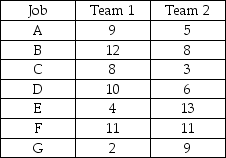Multiple Choice
Table J.17
A company must take on seven new projects. Each project has a planning stage and a design stage, and the planning stage must be completed before the design stage can begin. Also, two project teams are available to work on these projects: Team 1 works only on planning stages of projects, and Team 2 works only on design stages of projects. The times to complete the project stage, in days, are shown in the following table.

-Using the information in Table J.17 and Johnson's rule, develop a schedule that minimizes makespan for these seven jobs. Assume that job C could be neatly split into two equal parts, each having half of the processing time on each machine as the full job C. Using your original sequence, but splitting job C, what is the reduction in makespan for the seven jobs?
A) The schedule with job C split is almost a day longer.
B) The schedule with job C split is almost 2 days shorter.
C) The schedule with job C split is almost 2 days longer.
D) There is no difference between the makespan for the original schedule and that made with job C split into two halves.
Correct Answer:

Verified
Correct Answer:
Verified
Q21: Table J.2<br>Stu Dent reviews the syllabi he
Q22: Table J.2<br>Stu Dent reviews the syllabi he
Q23: Table J.2<br>Stu Dent reviews the syllabi he
Q24: The _ priority sequencing rule is typically
Q25: Table J.1<br>The framing department has six jobs
Q27: Table J.1<br>The framing department has six jobs
Q28: Table J.14<br>Gable Bakery has five cake orders
Q29: The shortest processing time rule tends to
Q30: Makespan is the total amount of time
Q31: The _ is a priority sequencing rule